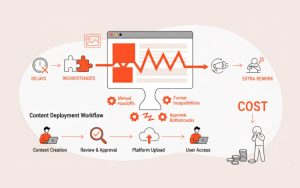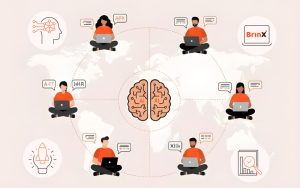Some learning teams have noticed that recommendation patterns shift in ways that are not immediately explained by role expectations or historical trends. A pathway that should be distributed across several job groups often clusters around just one, not dramatically, but consistently enough to draw attention.
When these patterns appear over multiple cycles, they prompt questions about how inputs are weighted and which variables influence the output more than intended.
These observations usually surface before any formal governance review begins, which indicates that ethical concerns tend to emerge inside everyday operational work rather than during structured audits.
As organizations continue refining AI-supported learning environments, these early signals serve as reminders that technical performance and ethical behavior are intertwined.
The systems handle data, assign relevance, and direct learners toward certain content, and each of these actions overlaps directly with privacy decisions, transparency expectations, and bias risks.
Once that connection becomes visible, the work naturally shifts abstract debate into practical design considerations.

Rethinking Privacy as a Core System Constraint
Privacy discussions in learning systems often begin by examining how much information is collected by default, because many platforms accumulate far more data than is actively needed for creating pathways or generating recommendations.
This includes timestamp trails, module-level click logs, inferred behavioral indicators, and demographic markers that rarely influence accuracy. The critical question becomes whether each variable genuinely serves the recommendation logic or simply occupies space without a defined operational purpose.
When teams treat privacy as a constraint rather than an add-on, system architecture starts to narrow in productive ways.
Models are built with limited inputs and expanded only when a demonstrated need appears. This reduces exposure risks and clarifies which variables matter. The approach also tends to reveal efficiencies.
For example, some organizations have discovered that removing low-impact metadata improves model consistency and simplifies review cycles. Over time, this habit of questioning each data element establishes a foundation that naturally connects to transparency, since teams must document why remaining inputs exist.
Key observations often emerge:
-
Sensitive variables rarely improve learning pathway accuracy.
-
Aggregated behavioral data usually retains utility even when anonymized.
-
Smaller input sets reduce validation and storage overhead.
These patterns create a bridge into the next area, because once privacy boundaries are established, teams must determine how to communicate the system’s functional logic to learners.

Making Transparency Operational Rather Than Explanatory
Transparency becomes meaningful when learners understand how their actions shape the system’s outputs, rather than receiving broad explanations that describe AI in general terms. Many organizations provide long statements outlining algorithmic concepts, yet these documents rarely clarify what matters at the moment a recommendation appears.
Learners still do not know which inputs influence relevance, which actions trigger recalibration, or which behaviors do not affect the system at all. When these gaps persist, confidence erodes quietly.
A functional approach works better. It involves pinpointing the specific interactions where decisions occur, and offering explanations grounded in those points. This does not require extensive detail. It requires accuracy.
When learners see a short panel that lists which inputs informed a suggestion, or how the system interpreted a recent activity, the information becomes practical rather than conceptual.
In several organizations, this type of explanation reduced inquiry tickets significantly, suggesting that people mainly want operational clarity.
Effective transparency models often include:
-
A brief description of the logic tied to key user actions.
-
Input indicators that reflect actual data sources rather than theoretical ones.
-
Localized explanations presented at the moment of decision, not buried in policy documents.
These clarifications prepare teams for bias review- because once decision points are visible, distribution patterns can be analyzed with more precision.

Treating Bias Review as an Ongoing Analytical Practice
Bias concerns rarely appear as large deviations. Instead, they build over time through slow, uneven patterns. Certain groups receive recurrent pathway suggestions that do not align with their responsibilities, or performance forecasts contradict managerial assessments. These patterns often persist for months before they attract attention.
As a result, reactive reviews tend to miss the underlying causes, while routine analytic cycles yield more actionable information.
Bias typically stems from three recurring factors: incomplete datasets, outdated role structures, or assumptions embedded in the pathway logic that no longer match real work. None of these emerge intentionally. They accumulate through system inheritance, rapid deployment schedules, or early configuration choices.
Addressing them requires cross-functional interpretation, because statistical flags do not always capture operational nuances. When bias reviews are aligned with talent cycles or quarterly planning, teams can compare pathway distribution with real organizational shifts and identify anomalies more effectively.
Common drivers to examine include:
-
Overrepresentation of high-visibility roles in training data.
-
Skill prerequisites that reflect legacy job architectures.
-
Metadata inherited from older systems that maps roles inaccurately.
With consistent review, systems become more stable, and learners begin experiencing more relevant pathways, which gradually contribute to trust.

Embedding Ethical Checks Within Existing Design Cycles
Trust forms through repeated system behaviors that remain stable across cycles. When learners see that privacy boundaries are clear, explanations are straightforward, and content recommendations feel appropriate; they develop a sense of predictability.
Predictability reduces hesitation. It influences how learners navigate suggestions, how often they accept recommendations, and how much manual searching they perform. These shifts are subtle but measurable over time.
Organizations also benefit from clearer operational baselines. When the system behaves consistently, deviations become easier to detect, which strengthens governance practices.
Teams can identify whether a drift arises from configuration changes, data shifts, or misaligned weighting. This reduces investigation time and provides a more grounded view of how the learning environment evolves.
Across multiple cycles, trust becomes less about perception and more about observable interaction patterns. Increases in acceptance rates, steady participation, and fewer clarification requests all indicate that ethical practices are functioning as intended.

A Brief Perspective on Ethical Alignment
Ethical guidelines often expand into long documents that sit outside day-to-day work. Their value increases when they integrate directly with design cycles, release planning, and ongoing evaluation. The most effective organizations do this by embedding small checkpoints into existing workflows.
During requirement gathering, teams review data inputs. During model tuning, they validate assumptions. During quarterly updates, they audit bias risks. None of these steps require separate processes. They attach tasks already being completed.
By distributing responsibility in this way, learning teams, analytics teams, and IT groups all maintain visibility into how ethical considerations influence technical behavior. Documentation stays practical rather than theoretical. Decision-making becomes more consistent.
Assumptions are questioned earlier in the cycle, which prevents complexity from accumulating unnoticed.
Practical integration usually involves:
-
Reviewing variable relevance during early scoping instead of after deployment.
-
Updating transparency elements alongside regular product release notes.
-
Linking bias audits to existing performance and capability review windows.
Over time, these embedded practices create a stable operational culture around AI in learning. It grows steadily, not abruptly, and anchors system behavior in predictable patterns that keep both learners and administrators aligned.

A Closing View on Ethical Alignment
When privacy limits are clear, decision logic is visible, and bias checks occur routinely, AI in learning behaves with steadier patterns that organizations can manage with fewer surprises. Over time, these small, consistent practices create systems that learners understand and trust without needing extensive explanation. Ethical alignment becomes less of a formal initiative and more of a natural outcome of disciplined design and review.

FAQs
What is AI in eLearning?
AI in eLearning refers to the use of artificial intelligence tools and models to automate, personalize, and optimize instructional design and learning delivery.
How is AI transforming instructional design?
AI is reshaping instructional design by automating repetitive tasks, generating data-driven insights, and enabling adaptive learning paths so designers can focus on creativity and strategy.
Can AI replace instructional designers?
No. AI enhances instructional design by managing mechanical tasks, allowing designers to invest their time in creativity, empathy, and alignment with business goals.
What are the benefits of using AI in eLearning?
Key benefits include faster course creation, adaptive personalization, smarter assessments, better learner analytics, and continuous improvement through feedback loops.
How does BrinX.ai use AI for instructional design?
BrinX.ai automates course structure, pacing, and assessment logic using AI-driven design principles, while maintaining strong version control and governance.
What challenges come with AI in eLearning?
The main challenges include ethical oversight, data bias, intellectual property questions, and ensuring human judgment remains central in the design process.
What instructional design models work best with AI?
Models like ADDIE, SAM, and Gagne’s 9 Events integrate seamlessly with AI, turning static frameworks into dynamic, data-responsive design systems.
How can AI improve learner engagement?
AI supports adaptive content, predictive nudges, and personalized reinforcement, aligning with motivation models like ARCS and Self-Determination Theory.
Is AI-driven learning content ethical?
It can be, when guided by transparency, inclusivity, and diverse data sets, ensuring that algorithms serve learning rather than bias it.
What’s next for AI in instructional design?
Expect AI to drive conversational learning, generative storytelling, and predictive analytics that anticipate learner needs before they arise.

Soft Skills Deserve a Smarter Solution
Soft skills training is more than simply information. It is about influencing how individuals think, feel, and act at work, with coworkers, clients, and leaders. That requires intention, nuance, and trust.









